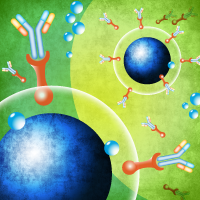Chaga, G., Andersson, L., Ersson, B. & Berg, M. Use of immobilized metal ions as a negative adsorbent for purification of enzymes: Application to phosphoglycerate mutase from chicken muscle extract and horseradish peroxidase. Biomed. Chromatogr. 6, 172–176 (1992).
Goubran Botros, H., Rabillon, J., Grégoire, C., David, B. & Dandeu, J. P. Thiophilic adsorption chromatography: purification of Equ c2 and Equ c3, two horse allergens from horse sweat. J. Chromatogr. B. Biomed. Sci. Appl. 710, 57–65 (1998).
Hansen, P., Scoble, J. A., Hanson, B. & Hoogenraad, N. J. Isolation and purification of immunoglobulins from chicken eggs using thiophilic interaction chromatography. J. Immunol. Methods 215, 1–7 (1998).
Huang, K., Lauridsen, E. & Clausen, J. The uptake of Na-selenite in rat brain. Localization of new glutathione peroxidases in the rat brain. Biol. Trace Elem. Res. 46, 91–102
Hutchens, T. W. & Porath, J. Thiophilic adsorption of immunoglobulins--analysis of conditions optimal for selective immobilization and purification. Anal. Biochem. 159, 217–26 (1986).
Kminková, M. & Kucera, J. Purification of carp (Cyprinus carpio) hepatopancreatic lactate dehydrogenase (EC 1.1.1.27). Prep. Biochem. Biotechnol. 28, 313–7 (1998).
Lutomski, D., Joubert-Caron, R., Bourin, P., Bladier, D. & Caron, M. Use of thiophilic adsorption in the purification of biotinylated Fab fragments. J. Chromatogr. B. Biomed. Appl. 664, 79–82 (1995).
Oscarsson, S., Angulo-Tatis, D., Chaga, G. & Porath, J. Amphiphilic agarose-based adsorbents for chromatography comparative study of adsorption capacities and desorption efficiencies. J. Chromatogr. A 689, 3–12 (1995).
Oscarsson, S., Medin, A. & Porath, J. Kinetic and conformational factors involved in chemisorption and adsorption of proteins on mercaptopyridine-derivatized agarose. J. Colloid Interface Sci. 152, 114–124 (1992).
Pedersen, B. J. & Bonde, M. Purification of human procollagen type I carboxyl-terminal propeptide cleaved as in vivo from procollagen and used to calibrate a radioimmunoassay of the propeptide. Clin. Chem. 40, (1994).
Porath, J., Belew, M., Maisano, F. & Olin, B. Group specific protein adsorbents based on "thiophilic" interaction. In B. Rand (Ed.) Physical Chemistry of Colloids and Macromolecules, Uppsala, Sweden, 137–142 (1984).
Porath, J. Immobilized Metal Ion Affinity Chromatography-A powerful method for protein purification. In H. Tschelsche (Ed.), Modern Methods in Protein Chemistry, Berlin & NY: Walter de Gruyter & Co., 85–95(1985).
Poulsen, C. & Stougaard, P. Purification and properties of Saccharomyces cerevisiae acetolactate synthase from recombinant Escherichia coli. Eur. J. Biochem. 185, 433–9 (1989).
Rosenkrands, I. et al. Identification and characterization of a 29-kilodalton protein from Mycobacterium tuberculosis culture filtrate recognized by mouse memory effector cells. Infect. Immun. 66, 2728–35 (1998).
Rosenkrands, I., Hejgaard, J., Rasmussen, S. K. & Bjørn, S. E. Serpins from wheat grain. FEBS Lett. 343, 75–80 (1994).
Samaraweera, P., Porath, J. & Law, J. H. Separation of insect hemolymph proteins by cascade-mode multi-affinity chromatography. Arch. Insect Biochem. Physiol. 20, 243–51 (1992).
Schulze, R. A., Kontermann, R. E., Queitsch, I., Dübel, S. & Bautz, E. K. Thiophilic adsorption chromatography of recombinant single-chain antibody fragments. Anal. Biochem. 220, 212–4 (1994).
Scoble, J. A. & Scopes, R. K. Ligand structure of the divinylsulfone-based T-gel. J. Chromatogr. A 787, 47–54 (1997).
Yurov, G. K., Neugodova, G. L., Verkhovsky, O. A. & Naroditsky, B. S. Thiophilic adsorption: rapid purification of F(ab)2 and Fc fragments of IgG1 antibodies from murine ascitic fluid.J. Immunol. Methods 177, 29–33 (1994).










